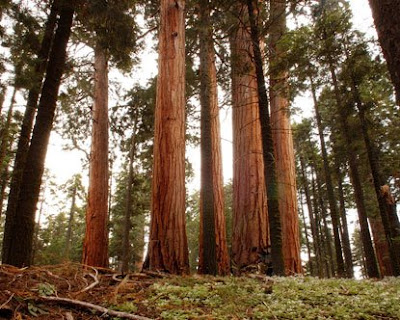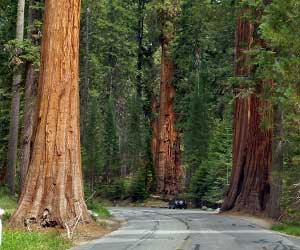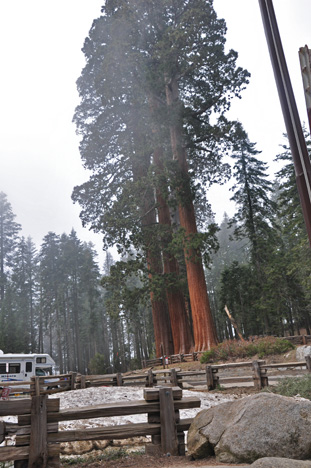One of the most majestic of the Wests signature trees is giant sequoia (Sequoiadendron giganteum) from the western slopes of the Sierra Nevada, where temperatures and soil moisture are conducive to its great growth. The roots of giant sequoia develop rapidly, which can increase the trees stability but makes transplanting difficult. Planting near a creek, especially in a flood plain, is not advisable. They will grow in hard soil very well but much slower.5)Protectyour seedlings from gophers, moles, snails and slugs. If there is not enough moisture in the soil available at that time the new layer will go undernourished and will not complete the task. The condition will disappear when sufficient irrigation is applied and the temperatures remain warm for an extended period in the spring.
To thrive, giant sequoia require a great amount of water, which they primarily receive from the Sierra snowpack that accumulates over the winter months and soaks into the ground when it melts. To learn more, visit our Redwood Forest Facts page.
Giant sequoias of all ages need soils that retain enough water to help them persist through the summer dry period.
Dormant plants need little to no sunlight in winter so the roof can be constructed of osb or plywood as well.
Young giant sequoias typically undergo color changes in the winter and early spring.
Our website gallery athttp://www.giant-sequoia.com/gallery/shows giant sequoias growing in many different places around the US and the world. The sap is a defense mechanism to keep insects from entering the damaged tissue. Only plants adapted to swamp-like conditions can handle the toxins.
Do not attempt to dig around the trees. Remove any damaged and dead lower branches by cutting them close to the trunk of the tree.
The soil must hold enough moisture for the tree to last through dry months, and should contain the endomycorrhizae on which the trees depend. With lowered light exposure, the plants are less able to compensate for the decreased photosynthesis and increased respiration levels caused by pollutants, so they absorb more pollutants and suffer more injuries. That would increase the trunk diameter by 2 inches per year. They have the potential to grow faster every year.
Through our Research Grants Program we have learned that: You can read more about League-funded research projects on our research grants page. Male and female cone buds appear around October.
Given excellent conditions and excellent gardening techniques the growth rings could approach 2 inches doubling the 100-year total to 34 feet in trunk diameter. If you have freezing weather but no snow then the container kept sequoias will have to be taken into a garage or cellar occasionally to be thawed and watered.
Failure to keep the soil moist results in a dead tree.
Please support our valued content sponsors.
Since giant sequoia is a shade intolerant species, it performs poorly in many urban areas, where buildings create large shadows and cloud cover may be greater than in rural regions. The cold is nota problem.
The mold causes the death of both leaf and root tissue, and may cause cankers in the main stem that eventually prove fatal. We have a warm season blend and a cool season blend.
Giant sequoia was believed to be one of the species most resistant to smog damage. Wintertime damage is done by wintertime dehydration from cold dry winds. Carpenter ants are possibly the most serious pests because they are associated with both fire scars (common in older trees and stands with previous fire damage) and with aphids found on white firs, a species commonly associated with giant sequoias. Some of the largest surviving giant sequoia groves can be seen in Sequoia and Kings Canyon National Parks, Giant Sequoia National Monument, Calaveras Big Trees State Park and Yosemite National Park.
The trees will be insulated from cold drying winds and be unable to dehydrate under the snow. There are no known diseases or insects that plague giant sequoias in the wild. Water moves upward from a shallow water table as if being drawn up by a sponge.
To help protect giant sequoia forests, we must study them. Vegetable plants generally need to be planted in the spring because they only live for one growing season. The only hope the bare rooted sequoia has is to regenerate the feeder roots before death from dehydration.
These fertilizers are available athttp://www.giant-sequoia.com/sites/giantsequoia/cart/plant-food.
In order to germinate, seeds first need to be released from their cones, which usually is facilitated by one of three agents.
The wintertime discoloration produces colors that are yet to be named by whoever names colors. Giant sequoia is generally propagated by seeds, which are subjected to cold stratification for about two months before being planted. Summers are dry with only occasional, and widely scattered, brief showers. Giant sequoia are generally well able to protect themselves against their natural threats, allowing them to survive for thousands of years. That would put the tree in competition with the largest diameter trees in the wild.
They will bend easily without breaking. The oldest known redwood fossils date back more than 200 million years to the Jurassic period.
Your tree is damaged and it might take some time to recover. The skin will crack and drops of sap will emerge and drip down the trunk and drop to the ground from the branches.
That leads to a build up of toxins.
The first is a wood-boring beetle (Phymatodes nitidus) whose larvae sever vascular connections in the cone scales, causing the scales to dry and release their seeds. 
Your resource for finding the best storage and home organization solutions for every room in the house. Under optimal conditions, a tree will reach a height of 250-275 feet and a diameter at breast height (four and a half feet above ground) of fifteen to twenty feet. Inoculating seedlings with VAM can help them grow two to three times larger than non-inoculated seedlings.
These arbuscules help transfer the soils mineral nutrients from the fungi to the giant sequoias, and sugars produced by the trees to the fungi, benefiting both. If you are attempting to grow specimen giants, 30 to 60 feet apart would be more appropriate. Save the Redwoods League is a 501(C)(3) nonprofit organization. The mycorrhizae also have organs called vesicles, which store nutrients and sugars.
Giant sequoias, because of their great potential size, can also create problems in the landscape.
Long-term occupation of sites by giant sequoias may greatly improve their soils. The Sequoiadendron giganteum (giant sequoia) is grown in all zones.
A tree should show no signs of damage to its roots or shoots from insects, fungi, or other biotic stresses.
You must never let the soil dry out completely. Giant sequoias live among other pines and firs in California's Sierra Nevada. What is important is the condition of the soil that you will be planting in. Trees grown in nurseries or outside the natural range of the species may be more vulnerable to biotic stresses than those growing within their natural range.
Due to its majestic stature, giant sequoia should only be planted in areas with abundant space, such as in parks, on campuses, or in large gardens. Some sequoia groves were logged in the late 1800s and early 1900s, but not very successfully.
Giant sequoias grow rapidly tall and less dense when the rising and setting sun is blocked.
People often talk about the giant sequoia in hyperboles, and for good reason: They make up many of the worlds oldest and tallest trees, and those with the thickest trunks and longest limbs. Were the only organization with the type of comprehensive approach needed to ensure that forests that take one thousand years to grow will be here for another thousand years. Naturalist John Muir dubbed the giant sequoia noblest of the noble, and its natural rangeis limited to CaliforniasSierra Nevadas (the western slopes).
While neither the tallest nor the widest tree known, giant sequoia is the worlds largest tree in total mass.
It is helpful for them to spend some time outside in the cold of winter basically resting and getting used to their environment.
The Gardenista editors provide a curated selection of product recommendations for your consideration.
Our goal is to create a comprehensive climate adaptation strategy for the redwoods.
The temperature of the soil is a factor as well as the chemical makeup of the soil. Meet our editorial team, see our book, and get the inside scoop on upcoming Gardenista events. I have seen this condition in trees up to five years old but never in older trees. Clicking through to the retailer that sells the product may earn us a commission.
Fire suppression policies in recent years have increased the growth of dense, brushy undergrowth and reduced the likelihood of giant sequoia regeneration.
Each season presents its own challenges to the grower.
Vesicular arbuscular mycorrhizae (VAM) are fungal-root associations wherein fungi penetrate the roots outer cell walls and form small, branched structures called arbuscules.
We have helped protect redwood forests and surrounding land totaling more than 200,000 acres (about the size of New York City).

Once they are buried deep in snow there will be no maintenance needed until the snow melts in the spring. Yet, because of its greater hardiness, giant sequoia has been cultivated in parks and gardens throughout much of the United States and Europe since its discovery in the early 1850s.
Sequoiadendron giganteum is the world's most massive tree. Along the western slopes of the Sierra Nevada, Privately owned giant sequoia forest: 1,200 acres, About the size of Golden Gate Park, San Francisco, California. Occasional flooding can be beneficial, unless the flooding is severe and sudden, loosening soil and damaging a trees roots.
Clean the debris away from the base of the trees being careful not to scrape the trunks. The investigation includes a network of forest plots that can be monitored for more than 100 years.
While this tree does not require much attention to pruning or fertilizing, gardeners may want to irrigate occasionally during dry periods, and allow a disturbance such as fire to occur in a large grove of trees in order to aid seedling growth and reduce competition from other trees.
A variety of wildlife species utilize giant sequoias for food and habitat.

